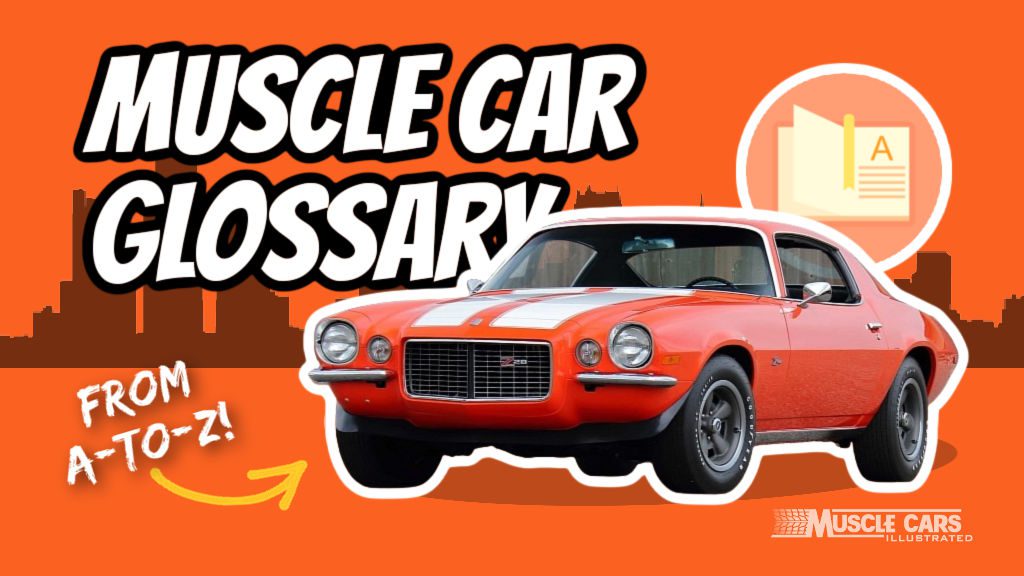
American muscle cars are some of the most beloved vehicles in automotive history, with their powerful engines and sleek designs capturing the hearts of enthusiasts for decades.
But with so many models, engines, and unique features, it can be hard to track them all. That’s why we’ve assembled the ultimate muscle car glossary, from the 442 to the Z28.
Whether you’re a seasoned muscle car enthusiast or just starting to explore this exciting world, this glossary will help you understand the terminology and features that make these cars so special.
Table of Contents
Muscle Car Terminology Made Easy
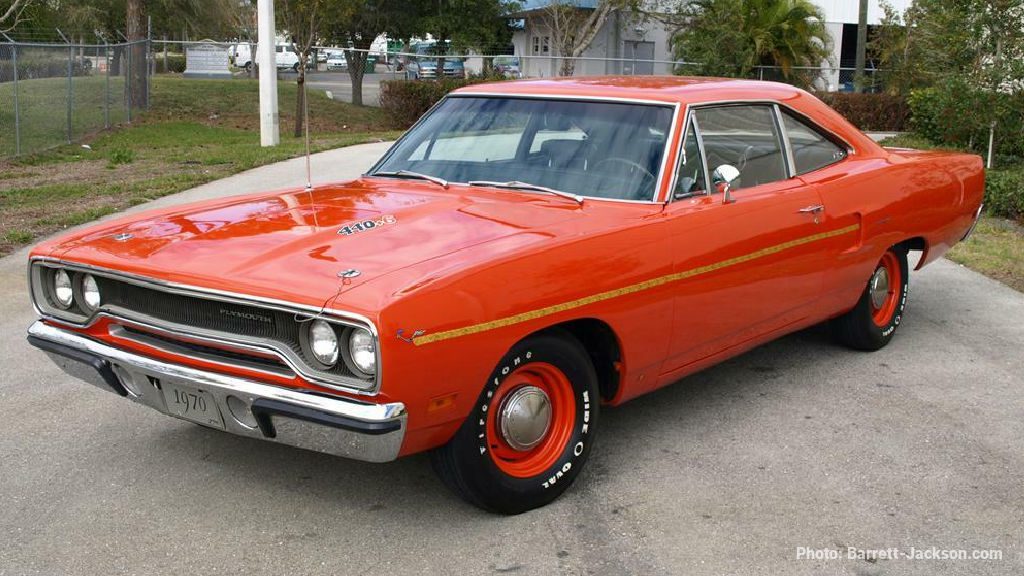
In this muscle car glossary, we’ll cover everything you need to know about muscle cars, from the terms like horsepower and torque to more specialized terms like Ram Air and Hemi.
We’ll explore the most iconic models from American automakers like Pontiac, Ford, and Dodge and lesser-known models from brands like AMC.
You’ll learn about the engines that powered these machines, the design features that made them unique, and the racing pedigree that helped them dominate on the track.
So buckle up, and let’s take a trip down memory lane with the ultimate muscle car glossary, shall we?
Muscle Car Speak: Your Essential Guide
Our muscle car glossary provides a comprehensive list of terms and definitions for the specific terminology taken from the muscle car history used during the 60s and 70s muscle car era.
Here we go:
Numbers
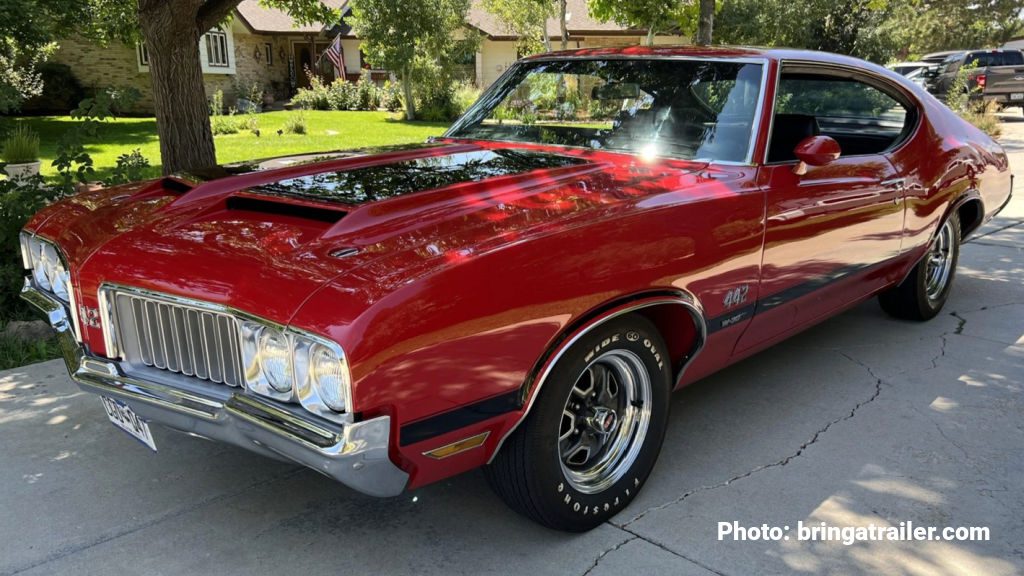
2+2: The name refers to the car’s seating arrangement. A 2+2 has two seats in the front and two in the back.
442: A high-performance model produced by Oldsmobile from 1964-1980. Initially, it represented having a 4-barrel carburetor, 4-speed transmission, and dual exhaust.
500: A trim level or package that various car manufacturers such as Ford and Mercury offer. The 1969 Dodge Charger 500 was a specific model of the Dodge Charger. It was not a trim level but a separate model intended to improve the Charger’s aerodynamics and make it more competitive on the NASCAR racing circuit. The Charger 500 was the predecessor to the Daytona.
727: A type of automatic transmission produced by Chrysler Corporation, known for its durability and high-performance capabilities.
3-speed: A type of manual transmission commonly used on American muscle cars, featuring three forward gears and a reverse gear.
4-speed: A type of manual transmission commonly used on American muscle cars, featuring four forward gears and a reverse gear.
A-C
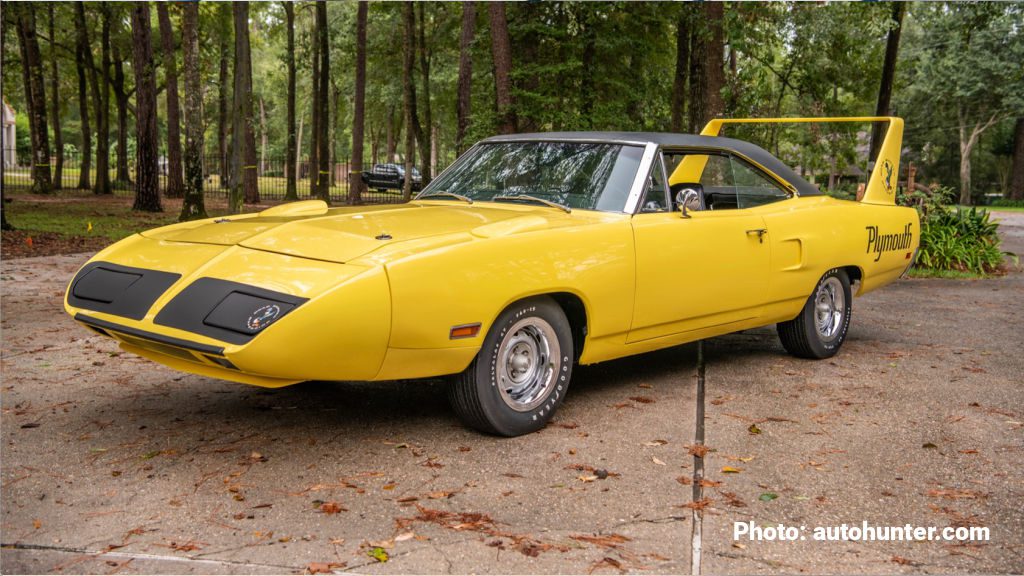
A12: A special option package offered on 1969 Dodge and Plymouth muscle cars. The code signifies installing a high-performance 440 Six Pack (Dodge) or 440 6 Barrel (Plymouth) engine, which featured three two-barrel Holley carburetors and produced a powerful 390 horsepower. The A12 package included heavy-duty suspension, a Dana 60 rear axle, a black fiberglass lift-off hood, and distinctive black steel wheels with redline tires.
A833: Chrysler Corporation produced the A-833 4-speed manual transmission, known for its durability and high-performance capabilities.
AAR: A high-performance model produced by Plymouth in 1970, featuring a 340 cubic inch V8 engine with a 6-bbl carburetor. AAR stands for “All American Racers,” a reference to the partnership between Plymouth and Dan Gurney’s racing team in the early 1970s.
Aero Car: A car designed with aerodynamics, often featuring a sloping or pointed nose and a large rear wing or spoiler. Examples include the 1969 Dodge Charger Daytona and the 1970 Plymouth Superbird.
Aero Warrior: A term used to describe the 1969 Dodge Charger Daytona, 1970 Plymouth Superbird, 1969 Ford Talladega, and 1969 Mercury Cyclone Spoiler II, designed for high-speed racing on NASCAR tracks.
Air Grabber: An air intake system featuring a distinctive hood scoop on select Plymouth Muscle Cars like the Roadrunner and GTX. The primary function of the Air Grabber hood was to provide a direct flow of cool, fresh air to the engine, thereby increasing its efficiency and power output. The Air Grabber hood worked through a vacuum-operated system. When activated, a vacuum-operated door, or “air grabber” scoop, would open on the hood, allowing outside air into the engine’s air intake. The driver could control the Air Grabber scoop using a switch located inside the cabin.
AMC: An American automobile manufacturer that produced various high-performance muscle cars in the 1960s and 1970s, including the AMX, Rebel Machine, and S/C Rambler. AMC stood for American Motors Corporation and was headquartered in Kenosha, WI.
AMX: A high-performance model produced by AMC. It started as a sports car model from 1968-1970. From 1971-1974, it became an option package for the Javelin.
Axel Ratio: The ratio between the number of rotations of the drive shaft and the rear axle. A higher ratio means better acceleration but lower top speed, while a lower ratio means better top speed but slower acceleration.
Barracuda: A pony car produced by the Plymouth division of the Chrysler Corporation from 1964 to 1974.
Belvedere: A full-sized car produced by the Plymouth division of the Chrysler Corporation from 1951 to 1970.
Big Bad: A series of bright and bold paint colors offered by American Motors Corporation, commonly used on the AMX.
Big Block: A type of V8 engine featuring a displacement of 396 cubic inches or greater.
Billboards: An optional decal found on 1971 Plymouth Cudas calling out the engine’s displacement.
Biscayne: A full-sized American car produced by the Chevrolet division of the General Motors Corporation from 1958 to 1972.
Boss: A high-performance model produced by Ford featuring powerful 302, 351, and 429 V8 engines.
Boss 302: A high-performance version of the Ford Mustang produced in 1969 and 1970. It featured a 302 cubic inch V8 engine and other performance upgrades.
Boss 351: A high-performance version of the Ford Mustang produced in 1971. It featured a 351 cubic inch V8 engine and other performance upgrades.
Boss 429: A high-performance version of the Ford Mustang, produced in 1969 and 1970. It featured a hemispherical combustion chamber design 429 cubic inch V8 engine, and other performance upgrades.
Broadcast sheet: A document containing information about a car’s original factory specifications and options, typically found hidden within the car’s body.
Buick: A Motor Division of General Motors that was known for producing select high-performance muscle cars, including the GS and GSX
Build sheet: A document containing information about a car’s original factory specifications and options, typically found hidden within the car’s body.
Bumble Bee: A type of stripe featuring two thin black stripes and a thicker colored stripe, commonly used on Dodge and Plymouth muscle cars.
Burnout: A driving maneuver where the driver spins the rear wheels while the car is stationary, creating a cloud of smoke and a loud tire screeching sound.
C6: A type of automatic transmission produced by Ford, known for its durability and high-performance capabilities.
Cale Yarborough: A NASCAR driver who drove for the Mercury racing team in the late 1960s and early 1970s. The 1969 Mercury Cyclone Spoiler II was named after him, featuring aerodynamic enhancements and high-performance engine options designed to dominate the NASCAR racing circuit.
Camaro: A pony car first introduced in 1967 by Chevrolet to compete with the Ford Mustang. It has been in continuous production for over 50 years, with various models and generations, including the high-performance Z28 and SS variants, being released.
Camshaft: The part of the engine that opens and closes the valves, controlling the air/fuel mixture and exhaust gases.
Carburetor: A device on a muscle car that mixes air and fuel in the proper proportion and distributes the mixture to the engine’s cylinders for combustion.
Carter: A manufacturer of carburetors commonly used on American muscle cars.
Challenger: A compact car model produced by the Dodge division of the Chrysler Corporation from 1970 to 1974.
Chin spoiler: A piece of bodywork at the bottom of the front bumper designed to improve aerodynamics and reduce drag. Also known as a front air dam.
Charger: A full-sized car model produced by the Dodge division of the Chrysler Corporation from 1966 to 1978.
Chevelle: A mid-size car model produced by the Chevrolet division of General Motors from 1964-1977. Chevrolet produced two muscle car versions: the Heavy Chevy and the Chevy Chevelle SS.
Chevrolet: A Motor Division of General Motors known for producing high-performance muscle cars, such as the Camaro, Chevelle, Nova, and El Camino.
CID: An abbreviation for cubic inches displacement, commonly used to indicate the size of an American high-performance engine.
Cleveland: A type of 351 cubic inch V8 engine produced by Ford, known for its high-performance capabilities and distinctive design features.
Clone: A car modified to look like a higher-end or more rare model. For example, a base Chevrolet Camaro that is modified to look like a Camaro Z/28.
Close Ratio: A type of manual transmission with a smaller difference between the gear ratios compared to the average transmission.
Cluster: The set of gauges located in the instrument panel of a car, including the speedometer, tachometer, fuel gauge, and other vital readings.
Cobra: A high-performance model produced by Ford, featuring a variety of powerful V8 engines and distinctive styling features.
Cobra Jet: A type of high-performance engine produced by Ford in the late 1960s and early 1970s, featuring a variety of powerful V8 engines, including 351, 428, and 429.
Column Shifter: A column-mounted shifter where the gear shift mechanism is located on the steering column of a vehicle.
Comet: A compact car model from the Ford Motor Company, produced from 1960 to 1977.
Compression: The ratio of the volume of the combustion chamber with the piston at the bottom of its stroke (largest volume) to the volume with the piston at the top of its stroke (smallest volume). A higher compression ratio generally means more power but requires higher-octane fuel to prevent detonation.
Convertible: A retractable roof that can be lowered or raised to allow the occupants to enjoy an open-air driving experience. The roof can be made of various materials, such as canvas or vinyl, and is typically operated either manually or automatically.
COPO: Chevrolet established the Central Office Production Order (COPO) system to enable dealers with fleet customers, such as municipalities and service operations, to place orders for customized batches of cars or trucks with specific equipment or colors to satisfy their requirements.
Coronet: A full-size car model produced by the Dodge division of Chrysler Corporation from 1949 to 1959 and then again from 1965 to 1976.
Cougar: A mid-size luxury car model produced by the Mercury division of Ford Motor Company from 1967-2002.
Coupe: A type of car body style featuring two doors and a passenger compartment separate from the trunk.
Cowl induction: An air intake system featuring a hood design that channels air directly into the engine from the rear, commonly used on high-performance muscle cars.
Cowl Tag: A metal tag on the cowl (the area between the windshield and the hood) of a car containing information about the car’s factory options and build specifications.
Cross Ram: A type of intake manifold featuring two four-barrel carburetors.
Cuda: A high-performance model produced by the Plymouth division of Chrysler Corporation from 1970-1974.
Cutlass: A mid-size car produced by the Oldsmobile division of General Motors from 1961 to 1999 and was the base for the 4-4-2 and Cutlass S.
Cutlass S: A mid-size car model produced by the Oldsmobile division of General Motors from 1961-1979.
Cyclone: A mid-size car model produced by the Mercury division of Ford Motor Company from 1964-1971.
D-F
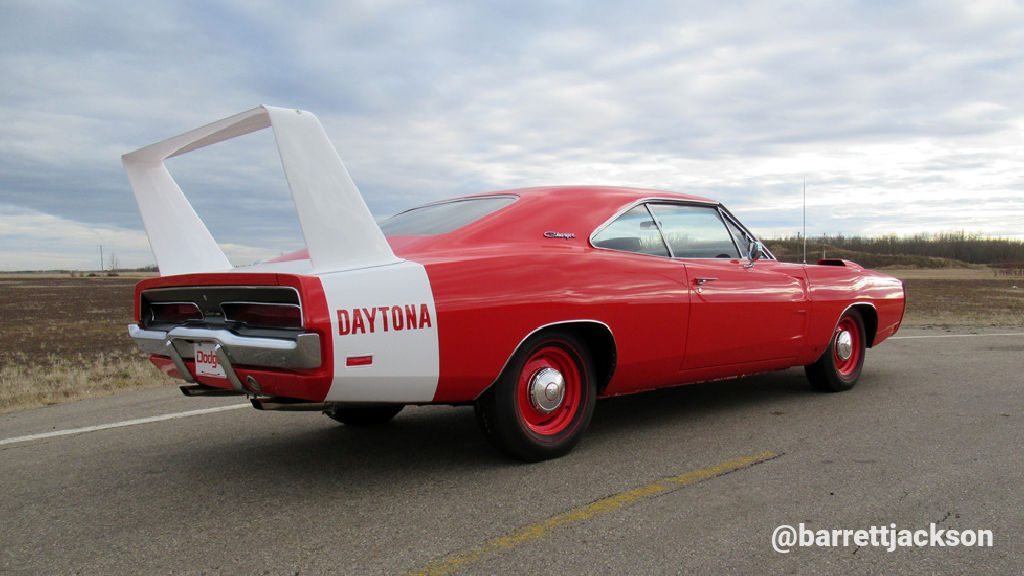
Dan Gurney: An American racing driver who competed for the Mercury racing team in the late 1960s. Two cars were named after him. The first was the 1969 Mercury Cyclone Spoiler II Dan Gurney Special, designed with aerodynamic enhancements and high-performance engine options to dominate the NASCAR racing circuit. The second was the 1969 Dan Gurney Mercury Cougar, a limited-edition muscle car based on the XR-7 platform.
Dana: The Dana 60 is a type of high-performance rear axle commonly used on Dodge and Plymouth muscle cars in the 1960s and 1970s, known for its durability and high-performance capabilities.
Dart: A compact car produced by the Dodge division of the Chrysler Corporation from 1960 to 1976.
Day one: A term used to describe a car that rolled off the dealer’s lot exactly as ordered from the factory.
Day two: A term used to describe a car modified with aftermarket performance parts and accessories, typically to enhance its performance and appearance, the day after buyers would bring their vehicle home from the dealer. Examples include aftermarket wheels, tires, headers, intakes, and carburetors.
Daytona: An upgraded 1969 Charger produced by the Dodge division of the Chrysler Corporation, featuring aerodynamic enhancements and high-performance engine options designed to dominate the NASCAR racing circuit.
Dealer Supercar: A term that describes an extremely high-performance muscle car modified by a dealer, typically with a rare engine option or limited production numbers. Examples include a Phase III Chevelle from Motion Performance and an SYC Camaro from Yenko Chevrolet.
Demon: A compact car produced by the Dodge division of the Chrysler Corporation from 1971 to 1972. The high-performance versions included a 340 cubic inch V8 engine.
Detroit Locker: A limited-slip rear differential offered by Ford, designed to improve traction and performance on muscle cars.
Dodge: A Motor Division of Chrysler Corporation known for producing supercars during the 1960s and 1970s, such as the Challenger, Charger, Coronet, and Daytona.
Dog Dish: A plain hubcap on a steel wheels’ center section.
Drag pack: An optional package Ford offers on select high-performance models featuring heavy-duty components designed for drag racing.
Drag Racing: A type of racing where two cars compete to see who can cover a straight eight-mile or quarter-mile track the fastest.
Dual Gate: A type of automatic transmission shifter made by Hurst featuring a unique gate system that allows for both automatic and manual shifting. Often referred to as a “His and Hers” shifter.
Dual plane: A type of intake manifold for a carbureted engine that has two separate passages to distribute air/fuel mixture to the cylinders.i
Dual quad: An engine with two four-barrel carburetors. For example, a 426 Hemi came with dual quad carburetors.
Duster: A compact car produced by the Plymouth division of the Chrysler Corporation from 1970-1976. The high-performance versions included a 340 cubic inch V8 engine.
Edelbrock: A manufacturer of high-performance aftermarket parts and accessories, including intakes and carburetors.
Eighth-mile: The 1/8-mile (660 feet or 201 meters) track distance focuses on swift acceleration and rapid launches. This shorter race format records metrics like reaction time, elapsed time, trap speed, and 60-foot time to assess a vehicle’s performance and the driver’s skills.
El Camino: A vehicle produced by the Chevrolet division of the General Motors Corporation from 1959 to 1960 and then again from 1964 to 1987. It was a unique vehicle that combined the utility of a pickup truck with the comfort and styling of a passenger car.
Eliminator: A high-performance version of the Cougar produced by the Mercury division of the Ford Motor Company from 1969 to 1970.
Endura: A type of front bumper made of a soft, durable synthetic material designed to absorb impact, first used on the 1970 Pontiac GTO.
Elapsed Time: ET is when a car completes a quarter-mile or eighth-mile drag race, starting from a standing stop.
Exhaust System: The system of pipes and mufflers that expels the exhaust gases from the engine.
Eye Brow Stripes: A type of racing stripe that runs over the front wheel wells of a car, giving it a distinctive look. Eye Brow stripes could be found on the Pontiac GTO Judge from 1970 to 1971.
Falcon: Initially released as a compact car, it was later classified as an intermediate one. Ford produced the Falcon from 1960-1970.
Factory Lightweight: A drag race only high-performance car produced with lightweight materials, stripped-down interiors, acid-dipped fenders, and components to improve performance from the factory. Examples include the 1964-65 Ford Thunderbolt and the 1963-64 Plymouth Savoy Lightweight.
Fairlane: A mid-size car the Ford Motor Company produced from 1955-1970.
Fastback: A car body style featuring a sloping roofline extending to the rear.
FE Engine: A type of V8 engine the Ford Motor Company produced from 1958 to 1976. The name “FE” stands for “Ford-Edsel,” as the engine was initially designed for the Edsel brand but later became a staple in Ford’s lineup of engines. Various sizes and configurations were available, ranging from 332 cubic inches to 428 cubic inches.
Fender Tag: A metal tag on the inner fender of a Dodge or Plymouth contains information about the car’s factory options and build specifications.
Firebird: A pony car produced by the General Motors Pontiac division from 1967-2002. The Firebird was the foundation vehicle for the Trans Am.
Forced Air: A type of air intake system featuring a snorkel that channels air directly into the engine, commonly used on high-performance Oldsmobile muscle cars.
Ford: Ford Motor Company is known for producing high-performance pony cars and muscle cars, such as the Mustang, Torino, Falcon, and Thunderbolt.
Formula: A high-performance version of the Pontiac Firebird produced from 1970-1974, featuring a variety of performance upgrades, including dual-snorkel hood scoops at the front of the hood.
Formula S: A high-performance version of Barracuda produced by the Chrysler Corporation Plymouth division from 1968-1969.
G-I
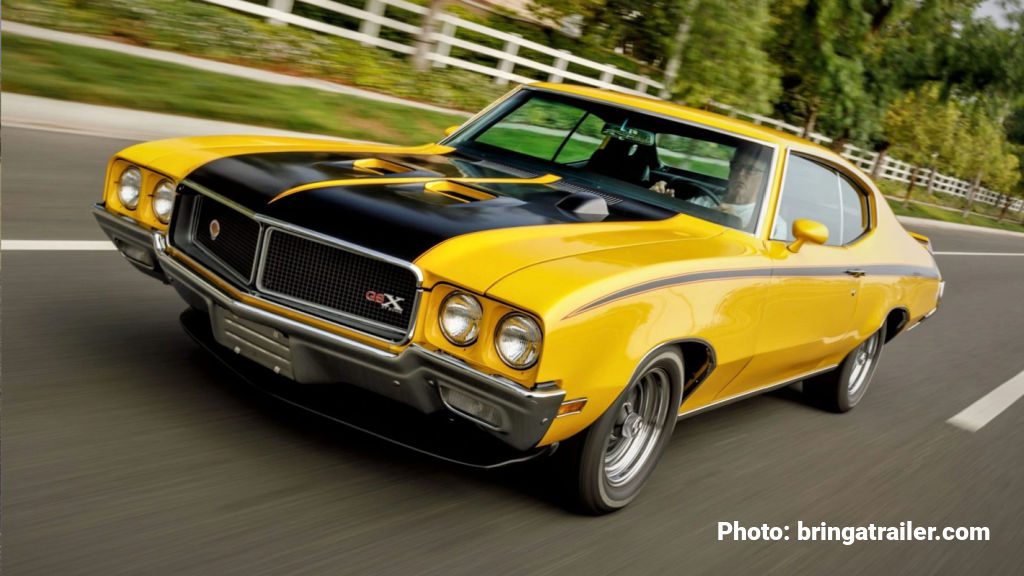
Galaxie: A full-size car produced by Ford Motor Company from 1959-1974.
Gear Ratio: The ratio between the number of teeth on the ring gear and pinion gear in the rear end determines the torque applied to the wheels.
Gills: A series of slits or openings in the side of a car, often used to improve airflow or ventilation. Examples include the “gills” on the side of a 1971 Plymouth Cuda.
Goat: A nickname for the Pontiac GTO. It stands for “Greatest of All Time.”
Grabber: A type of paint color used on high-performance Ford muscle cars in the 1970s, featuring bright and bold colors, including yellow, orange, blue, green, and blue.
Group 19: A series of high-performance components available from AMC parts counters in the late 1960s and early 1970s to improve the performance and handling of the vehicle.
GS/Gran Sport: General Motors Buick division produced a high-performance model called the GS from 1965-1972.
GSX: GSX stands for “Gran Sport Experimental.” The Buick GSX was a high-performance variant of the Buick GS from 1970-1972.
GT: A name used by various car manufacturers, including Ford, Chevrolet, Pontiac, Dodge, and Plymouth, to denote high-performance models designed for racing and performance driving. It stood for “Grand Touring.”
GT350: A high-performance model Shelby America produced, featuring a 289 or 351 cubic inch V8 engine, depending on the year.
GT350H: A special version of the Shelby GT350 produced for Hertz rental car company, featuring a 289 or 351 cubic inch V8 engine, depending on the year.
GT500: A high-performance model produced by Shelby America, featuring a 428 cubic inch V8 engine.
GT-37: A mid-performance variant of the popular Pontiac Tempest model produced for just two years, from 1970 to 1971.
GT500KR: The “King of the Road” version of the Shelby GT500 had a higher horsepower 428-cubic-inch V8 engine. The GT500KR also featured various upgrades, including suspension and brake improvements, a functional hood scoop, and distinctive styling cues.
GTA: A name used by Ford on two different models, including the 1965-1967 Ford Mustang GTA (Gran Turismo Automatic) and the 1966-1967 Ford Fairlane GTA.
GT-E: A bonafide high-performance package of the Mercury Cougar, produced in 1968. Available with either a 427 side oiler or a 428 Cobra Jet V8 engine, and had several upgrades over the standard Cougar, such as heavy-duty suspension and power front disc brakes.
GTO: A mid-size car produced by the Pontiac division of General Motors from 1964-1974 and often referred to as the first muscle car. GTO stands for “Gran Turismo Omologato,” which is Italian for “Grand Touring Homologated.” Ferrari originally used it to denote a racing car that had been homologated or approved for production with the necessary changes to meet the regulations of a particular racing series.
GTS: A high-performance model of the Dart produced by the Dodge division of the Chrysler Corporation from 1967 to 1968. Available with a 340 or 383-cubic-inch V8 engine.
GTX: A high-performance model produced by the Plymouth division of the Chrysler Corporation from 1967 to 1971. GTX emblems appeared on the 440 cubic inch V8-equipped Roadrunners from 1971 to 1974.
Hardtop: A body style where the roof is made of solid material and does not have a retractable or removable top.
Headers: Metal tubes that connect the engine’s cylinders to a common exhaust pipe, and are designed to improve the engine’s performance by reducing exhaust back pressure and improving the flow of exhaust gases. Headers replace the stock exhaust manifolds and are a popular aftermarket “Day Two” upgrade for muscle cars.
Heavy Chevy: A special edition of the Chevrolet Chevelle from 1971 to 1972 for buyers looking for the looks of an SS and similar performance but without the higher insurance premiums.
HEMI: An engine design featuring hemispherical combustion chambers, known for its high-performance capabilities and distinctive sound. The most popular during the muscle car era was the 426 HEMI engine.
Hertz: A car rental company partnered with several American auto manufacturers to produce special versions of high-performance muscle cars for rental.
Hi-Po: An abbreviation for high-performance, commonly used to describe engines with powerful performance capabilities.
High Impact Colors: A series of bright, bold paint colors used on Plymouth muscle cars in the 1970s. Examples include Vitamin C, Tor Red, In-Violet, and Limelight.
High Performance Colors: A series of bold and distinctive paint colors used on high-performance Dodge muscle cars in the 1960s and 1970s. Examples include Go Mango, Hemi Orange, Plum Crazy, and Sublime Green.
H/O: An abbreviation for Hurst/Olds, a high-performance model produced by Oldsmobile in collaboration with Hurst Performance. It was also an abbreviation for “High Output” on select Pontiac engines.
Holley: A manufacturer of high-performance carburetors commonly used on American muscle cars.
Holiday Coupe: A term used by Oldsmobile to describe a hardtop body style with no B-pillar center posts.
Homologation: The process of meeting specific requirements or rules set forth by a racing-sanctioning body to make a car eligible for racing in a certain class or series. This often involved producing a certain number of street-legal versions of the car with the required components or modifications to be considered for racing. Many manufacturers used this to promote their high-performance models and gain credibility on the track. Examples include the Plymouth Superbird, Boss 429, and Mark Donahue Javelin.
Honeycomb Wheels: A type of wheel featuring a distinctive honeycomb design, used on high-performance Pontiac muscle cars in the 1970s.
Hood pins: A type of latch used to secure the hood of a high-performance muscle car in place at high speeds.
Hood Scoop: A design feature that can be both functional and non-functional. Functional hood scoops are designed to actively channel air into the engine compartment, while non-functional hood scoops are simply for show and do not provide additional airflow.
H-pipe: A type of exhaust system featuring a crossover pipe that connects the two sides of the exhaust system, commonly used on high-performance muscle cars.
Hood Tach: A hood-mounted tachometer.
Horsepower: An engine’s power is usually measured in horsepower (hp).
Horseshoe Shifter: General Motors produced an automatic transmission shifter in the center console with a unique horseshoe-shaped design.
Hurst: Hurst Performance was an original equipment manufacturer (OEM) and aftermarket parts manufacturer known for producing high-quality shifters. Hurst was also known for their car collaborations with auto manufacturers in the ’60s and ’70s.
Impala: A full-size car produced by the Chevrolet division of General Motors Company from 1958 as a top-of-the-line model for Chevrolet, it remained in production until 1985. The Impala was later reintroduced in 1999 and then canceled again in 2020.
Intake Manifold: The part of the engine that delivers the air and fuel mixture to the combustion chambers.
J-L
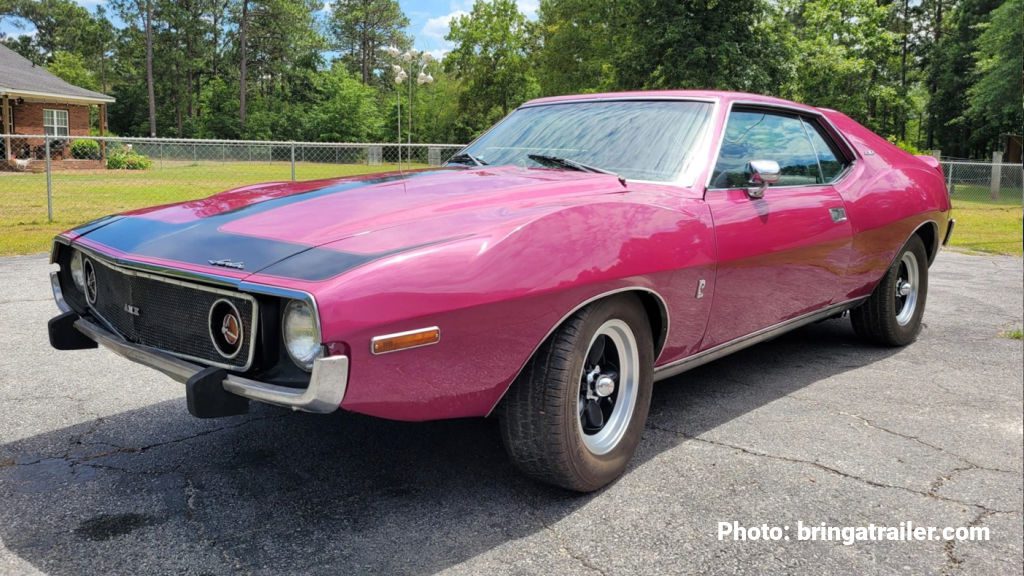
Javelin: A two-door hardtop car model produced by the American Motors Corporation (AMC) from 1967 to 1974. It was designed to compete with other pony cars of the era, such as the Ford Mustang and Chevrolet Camaro.
Judge: A high-performance option on the GTO produced by the Pontiac division of General Motors from 1969 to 1971. The GTO Judge package added various decals, stripes, and a rear spoiler, among other items.
King Cobra: A prototype car in 1970 that was designed to be a successor to the Ford Torino Talladega in NASCAR racing.
L88: A high-performance 427 cubic inch V8 engine produced by Chevrolet in the late 1960s, known for its powerful performance capabilities and limited production numbers.
L89: A special version of the L88 427 cubic inch V8 engine featuring aluminum cylinder heads, known for its high-performance capabilities and limited production numbers.
LA Engine: A type of small block V8 engine produced by Chrysler in the 1960s and 1970s, known for its high-performance capabilities and distinctive design features.
Ladder bars: An aftermarket suspension modification used on muscle cars to improve traction and reduce wheel hop during hard acceleration. Also known as traction bars.
Laguna: A mid-size version of the Chevelle produced by the Chevrolet division of General Motors from 1973-1976.
LeMans: A mid-size car produced by the Pontiac division of General Motors from 1962 to 1981 and was the base for the GTO, Sport, and GT.
Limited Slip: A type of rear differential designed to improve traction and performance, commonly used on high-performance muscle cars.
LS5: A high-performance engine produced by Chevrolet in the 1970s, featuring a 454-cubic-inch displacement and high horsepower capabilities.
LS6: A high-performance engine produced by Chevrolet in the 1970s, featuring a 454-cubic-inch displacement with 450 horsepower.

Get The Top 50 Fastest Muscle Cars chart. Includes year, model, engine, 1/4 mile times, and more—absolutely free!
M-O
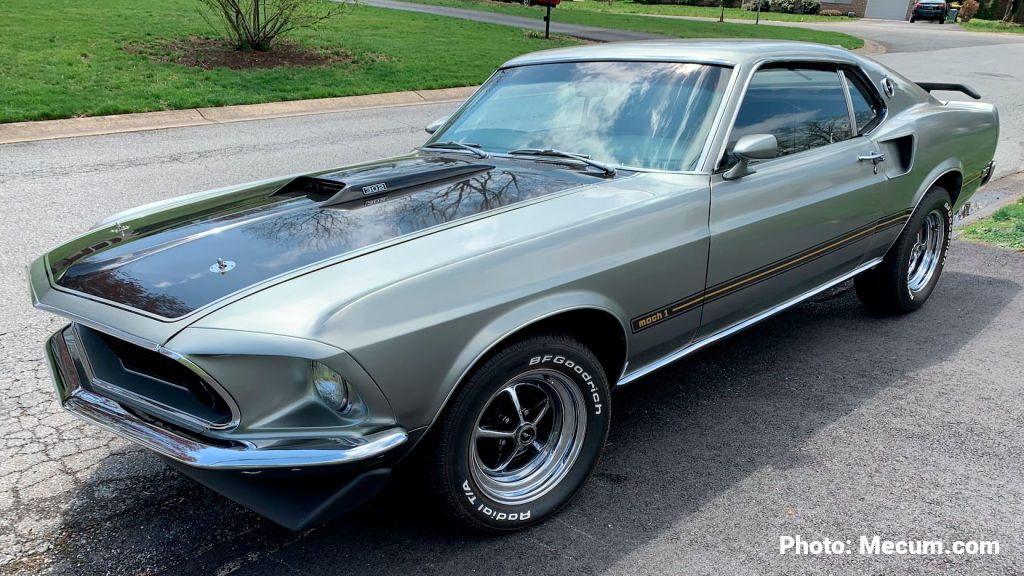
Mach 1: A high-performance version of the Ford Mustang produced by the Ford Motor Company from 1969-1974. It was named after the term “Mach 1,” which refers to the speed of sound in air. The name evoked a sense of speed, power, and cutting-edge technology. Although the Mach 1 Mustang could not achieve speeds near the speed of sound, the moniker effectively conveyed the car’s performance capabilities and positioned it as a formidable competitor in the muscle car market.
Mag Wheels: A type of wheel made from magnesium alloy, commonly used on high-performance muscle cars in the 1960s and 1970s.
Magnum: A type of engine produced by Chrysler in the 1960s and 1970s, known for its high-performance capabilities.
Magnum 500: A type of wheel featuring a distinctive five-spoke design, commonly used on high-performance Ford muscle cars in the 1970s.
Malibu: A mid-size car produced by the Chevrolet division of General Motors from 1964 to 1983 and was the base for the Chevelle.
Mark Donahue: An American race driver who competed for the American Motors Corporation (AMC) racing team in the late 1960s and early 1970s. He was honored with a special edition Javelin named after him—the 1970 AMC Javelin SST Mark Donohue Edition. The car celebrated his successful racing career and featured unique styling elements, including a special paint scheme and spoilers. It also had high-performance upgrades for improved speed and handling. This model was used to homologate the rear spoiler for SCCA racing.
Marti Report: A company that specializes in producing detailed production reports for Ford vehicles, commonly used to verify the authenticity of a muscle car.
Matching Numbers: A term used to describe a muscle car where the engine, transmission, and rear axel all have the same identification numbers as when the car was originally produced.
Mercury: A Division of Ford Motor Company that produced high-performance muscle cars, such as the Cougar, Cyclone, and Marauder.
Monte Carlo: A mid-size luxury car produced by the Chevrolet division of General Motors on and off between 1970 to 2007.
Montego: A mid-size car produced by Mercury from 1968 to 1976. It was initially introduced as a high-end version of the Mercury Comet and later spun off into its model line.
MOPAR: A term used to refer to Chrysler Corporation and its various divisions, including Dodge and Plymouth.
Motion Performance: A high-performance tuner and dealer during the muscle car era that specialized in modifying Chevrolet vehicles with powerful engines and other performance upgrades.
Muncie: A type of manual transmission produced by General Motors, commonly used on high-performance muscle cars in the 1960s and 1970s.
Muscle Car: The definition of a muscle car describes a high-performance mid-size car produced in the 1960s and 1970s featuring a powerful V8 engine built for straight-line performance.
Muscle Car Era: The period from the mid-1960s to the early 1970s when muscle cars were at their peak of popularity and performance.
Mustang: A pony car made by the Ford Motor Company that has been in continuous production since 1964. The Mustang was the first pony car that sparked the Chevy Camaro, Pontiac Firebird, Mercury Cougar, Dodge Challenger, and Plymouth Cuda.
Nova: A compact car produced by the Chevrolet division of General Motors from 1962-79, 1985-1988.
Oldsmobile: A motor division of General Motors known for producing high-performance muscle cars, such as the 442 and the Cutlass.
Oval Port: A type of cylinder head design commonly used on high-performance engines, featuring large, oval-shaped intake and exhaust ports.
P-R
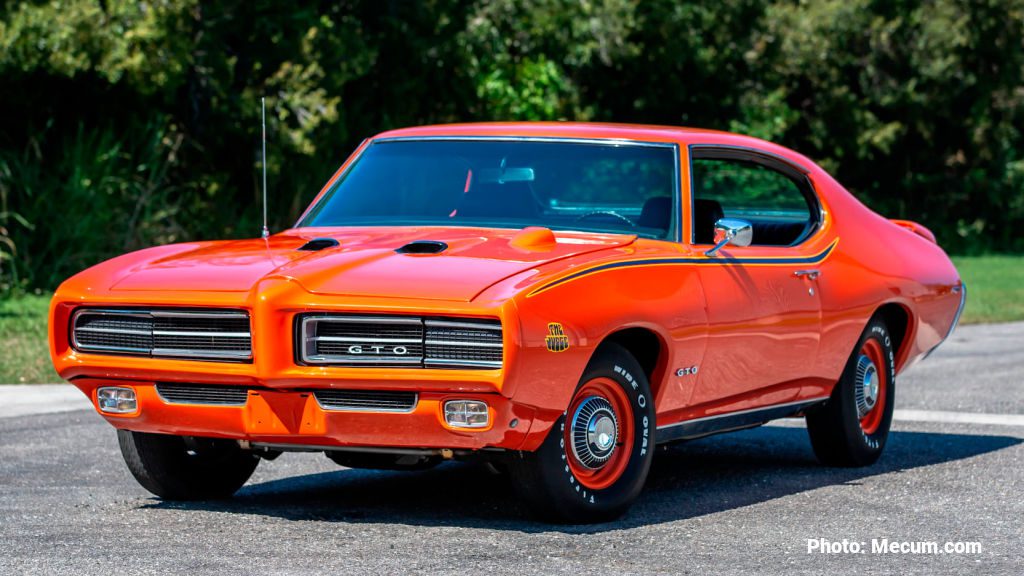
Paxton: A manufacturer of superchargers commonly used on high-performance muscle cars.
PHS: An abbreviation for Pontiac Historical Services, a company that specializes in producing detailed production reports for Pontiac vehicles, commonly used to verify the authenticity of a muscle car.
Pierre Cardin: A famous fashion designer who collaborated with AMC to create a special edition version of the AMC Javelin and Javelin AMX from 1972 to 1974.
Pistol Grip: A type of shifter handle produced by Hurst Performance, used on Mopar muscle cars with 4-speed manual transmissions during the early 1970s.
Pistons: The parts of the engine that move up and down to compress the air/fuel mixture and generate power.
Plymouth: A Motor Division of Chrysler Corporation known for producing high-performance muscle cars, such as the Barracuda, Road Runner, GTX, and Superbird.
Polara: A full-size car produced by the Dodge division of the Chrysler Corporation from 1960-1973.
Pontiac: A Motor Division of General Motors that was known for producing high-performance muscle cars during the muscle cars era, such as the GTO, Firebird, and Trans Am
Pony Car: A term used to describe a compact, sporty car with a long hood and short rear deck, typically featuring a powerful V8 engine, and exemplified by models such as the Ford Mustang, Pontiac Firebird, Plymouth Barracuda, Dodge Challenger, and Chevrolet Camaro.
Positraction: A type of rear differential designed by General Motors to improve traction and performance, whereby both rear wheels spin simultaneously.
Protect-O-Plate: A metal plate attached to the engine of a high-performance muscle car, containing important information about the car’s original configuration and options.
Quarter-mile: A quarter-mile is the traditional 1/4-mile (1,320 feet or 402 meters) track distance in head-to-head races, measuring straight-line performance and speed. Metrics like reaction time, elapsed time, trap speed, and 60-foot time are recorded to assess the vehicle’s performance and the driver’s skills.
Racing Stripes: A type of decorative stripe painted on the hood and sides of a high-performance muscle car, commonly used to denote a high-performance model.
Rally Sport: An option package that first appeared on the 1967 Chevrolet Camaro. An RS included several performance and styling upgrades, including special exterior trim, hidden headlights, and a revised suspension system.
Rally Wheels: A type of wheel from Chevrolet, Pontiac, and other American car manufacturers.
Rally II: A type of wheel option for Pontiac muscle cars in the 1960s and 1970s. They were a five-spoke design with a flat face and small triangular cutouts on the spokes.
Rallye: A high-performance model produced by Dodge that was available on the Challenger and Charger platforms from 1972-1974. It was the replacement for the R/T package.
Ram Air: A type of induction system designed to increase engine performance by directing cool, dense air into the engine through a hood scoop or other intake system.
Ram Air I: A high-performance 400 cubic inch V8 engine produced by the Pontiac division of General Motors in 1967.
Ram Air II: A high-performance 400 cubic inch V8 engine produced by the Pontiac division of General Motors in 1968.
Ram Air III: A high-performance 400 cubic inch V8 engine produced by the Pontiac division of General Motors from 1969 to 1970.
Ram Air IV: A high-performance 400 cubic inch V8 engine produced by the Pontiac division of General Motors from 1969 to 1970.
Ram Air V: A prototype racing engine developed by Pontiac in the late 1960s with tunnel port heads. Available as a 303 for SCCA Trans-Am series or a 400 cubic inch V8 engine. The RAV was never offered in a production vehicle.
Ram Charger: A functional hood scoop used on Dodge vehicles in the late 1960s and early 1970s. The Ram Charger hood allowed more air to flow into the engine compartment, increasing performance. It worked through a vacuum-operated system. When activated, a vacuum-operated door, or “ramcharger” scoop, would open on the hood, allowing outside air to be drawn directly into the engine’s air intake. When deactivated, the scoop would close, offering a more discreet appearance and minimizing the intake of dirt and debris. The driver could control the Ram Charger scoop using a switch located inside the cabin.
Ram Rod 350: This was an optional high-performance engine offered by Oldsmobile in the late 1960s. The Ram Rod 350 was popular with muscle car enthusiasts due to its high horsepower output.
Rapid Transit System: A marketing campaign by Plymouth in the late 1960s and early 1970s promoting a series of high-performance muscle cars with distinctive graphics and performance features.
Rear End: The differential and axle assembly transfers power from the engine to the wheels.
Rear Spoiler: This aerodynamic feature was added to some muscle cars to increase downforce and improve stability at high speeds.
Redline: On a tachometer, a redline is the maximum recommended engine speed for a vehicle, marked in red on the gauge.
Redlines: A type of tire featuring a distinctive red stripe on the sidewall.
Road Runner: A muscle car produced by the Plymouth division of the Chrysler Corporation from 1968 to 1980. It was the first budget, no-frills muscle car.
Rockcrusher: A type of manual transmission produced by Muncie, known for its heavy-duty construction and high-performance capabilities.
R/T: A high-performance model option on the Challenger, Charger, and Coronet produced by the Dodge division of Chrysler Corporation. R/T stands for Road/Track.
Round Port: A type of cylinder head design commonly used on high-performance engines, featuring circular intake and exhaust ports.
Royal Bobcat: A high-performance package for the Pontiac GTO created by Royal Pontiac, a well-known dealership and tuning shop in Royal Oak, Michigan.
Royal Pontiac: A dealership and high-performance tuning shop in Royal Oak, Michigan, that was active from the 1950s to the early 1970s.
S-U
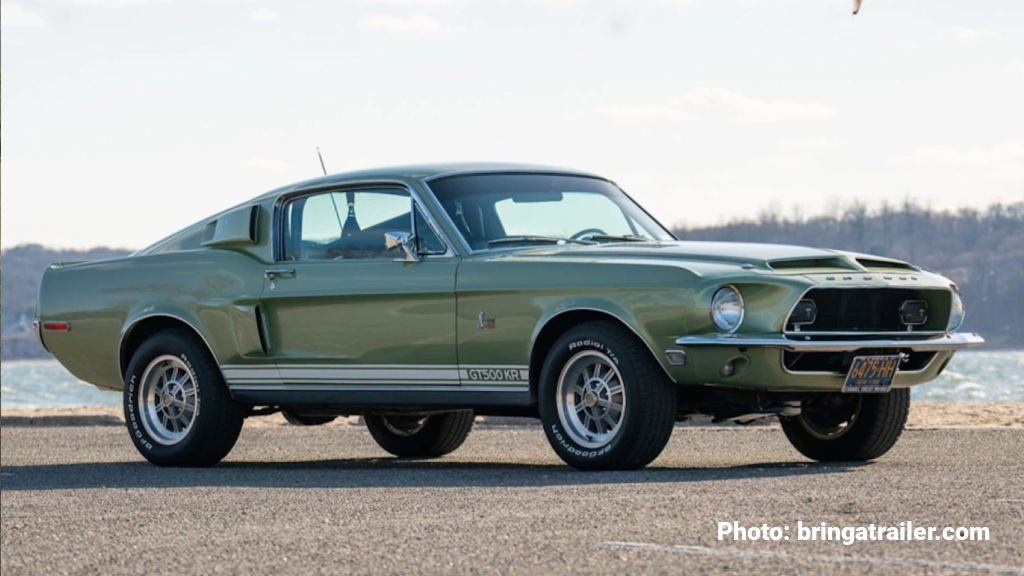
Satellite: A mid-size car produced by the Plymouth division of the Chrysler Corporation from 1965-1974.
Scat Pack: A marketing campaign by Dodge in the late 1960s and early 1970s promoting a series of high-performance muscle cars with distinctive graphics and performance features.
SC/Rambler: A high-performance model produced by American Motors Corporation featuring a 390-cubic-inch V8 engine and distinctive red, white, and blue paint scheme.
Sedan: A type of car with two doors and door pillars.
Shaker: A hood scoop used on various high-performance muscle cars, attached directly to the engine and visible through a hole in the hood.
Shelby: A high-performance version of the Ford Mustang produced by Carroll Shelby, including the GT350, GT500, and GT500KR.
Sidepipes: An exhaust system featuring pipes that exit through the car’s sides, commonly used on high-performance muscle cars in the 1960s and 1970s.
Single plane: An intake manifold design with a single large opening, allowing air to flow directly into the engine.
Six Barrel: An induction system featuring three two-barrel carburetors used on high-performance Plymouth muscle cars in the 1960s and 1970s.
Six Pack: An induction system featuring three two-barrel carburetors used on high-performance Dodge muscle cars in the 1960s and 1970s.
SkyLark: A mid-size car produced by the Buick division of General Motors from 1964 to 1972 and was the base for the GS/GSX.
Slapstik: A type of automatic transmission shifter produced by Chrysler, featuring a unique design that allowed drivers to shift gears quickly by slapping the shifter forward or backward.
Sleeper: This term refers to a car that looks unassuming on the outside but has a powerful engine under the hood.
Small Block: A type of V8 engine produced by American automakers, typically with a displacement of 350 cubic inches or less, and known for their high-revving capabilities and relatively compact size.
Snorkel: A type of air cleaner used on high-performance muscle cars, designed to draw in cold, dense air from outside the engine compartment.
Spoiler: A device added to a high-performance muscle car’s front and/or rear to improve its aerodynamics and handling at high speeds. Additionally, Spoiler was a Cyclone model produced by Ford’s Mercury division in 1970 and 1971.
Spoiler II: A high-performance version of the Cyclone produced by the Mercury division of the Ford Motor Company in 1969 for NASCAR homologation.
Sport: A term used on several muscle cars, including the Dodge Dart Sport, Plymouth Valiant Duster Sport, Pontiac LeMans Sport, and Mercury Cyclone GT Sport.
Sport Coupe: A term used by Oldsmobile to describe a hardtop body style with B-pillar center posts.
Sport Fury: A high-performance version of the Plymouth Fury produced in the late 1960s and early 1970s.
SS/AMX: This was a race-only version of the 1969 AMC AMX, produced specially modified and prepared for NHRA and AHRA drag racing competitions. It was not street-legal.
SST: SST stands for Super Sport Touring. The SST was a trim-level option offered on several AMC models, including the Javelin, Gremlin, and Hornet. The SST package typically included interior and exterior upgrades, such as a center console, bucket seats, sport steering wheel, special badging, and sometimes upgraded engine options.
SS427: This was a high-performance stand-alone model in the Chevrolet Impala family, which featured a 427 cubic inch V8 engine.
Stage 1: A high-performance engine option produced by Buick in the late 1960s and early 1970s, known for its powerful performance capabilities and distinctive design features.
Strobe Stripes: This refers to a type of racing stripe that alternates between two or more colors, creating a flashing or strobing effect. Strobe stripes were available on Plymouth Road Runners from 1971-1974.
Suspension: The system of springs, shocks, and other components that support the car’s weight and provide a smooth ride.
Super Bee: A high-performance model produced by Dodge from 1968-1971. It was based on the Coronet from 1968-1970. Then it jumped to the Charger in 1971.
Superbird: An upgraded 1970 Plymouth Roadrunner featuring aerodynamic enhancements and high-performance engine options designed to dominate the NASCAR racing circuit.
Super Cobra Jet: A high-performance package produced by Ford in the late 1960s and early 1970s. It appeared on Torinos and Mustangs, featuring larger valves, a revised camshaft, and other upgrades that increased horsepower.
Super Cyclone Spoiler II: A prototype car to compete in NASCAR that Mercury developed in 1970. The Super Cyclone Spoiler II was based on the Cyclone GT and featured a redesigned aerodynamic front end and other performance upgrades.
Super Duty: A high-performance engine option produced by Pontiac in the late 1960s and early 1970s.
Super Snake: A limited number of GT500 models were modified with a 427 cubic inch V8 “side oiler” engine by Shelby American as part of their “Super Snake” package, featuring extensive modifications and upgraded suspension and brake components.
Super Sport: A high-performance model produced by Chevrolet, also known by the “SS” abbreviation, featuring a variety of powerful V8 engines. It appeared on the Chevelle, Camaro, Impala, El Camino, Corvette, and Nova.
Super Stock: A term used to describe a factory-produced race car, typically with various performance upgrades and specialized components.
Super Track Pack: A performance package offered by Dodge in the late 1960s and early 1970s, featuring a variety of performance upgrades and a SureGrip limited-slip differential.
Supercar: This term refers to a high-performance car capable of high speeds and quick acceleration. Supercar was the name used for a muscle car in the 1960s and 1970s.
Sure Grip: A limited-slip differential produced by Chrysler, designed to improve traction and performance on muscle cars.
Swinger: A two-door hardtop model of the Dodge Dart compact car that the Dodge division of Chrysler Corporation produced from 1969 to 1976. The high-performance versions came with a 340 cubic inch V8 engine.
SYC: An abbreviation for “Yenko Super Car,” a series of high-performance muscle cars produced by Yenko Chevrolet in the late 1960s and early 1970s, featuring a variety of performance upgrades and limited production numbers.
T-37: A mid-size muscle car produced by Pontiac from 1970 to 1971. It was based on the Tempest platform and was designed to be a more affordable version of the GTO.
Talladega: An American muscle car produced by the Ford Motor Company in 1969, featuring aerodynamic enhancements and high-performance engine options designed to dominate the NASCAR racing circuit.
T-Handle: A type of shifter knob produced by Hurst Performance, commonly used on high-performance muscle cars with manual transmissions.
T/A: An abbreviation for “Trans Am.” Pontiac and Dodge used this on select muscle car models, including the Pontiac Firebird Trans Am and 1970 Dodge Challenger T/A.
Tempest: The Pontiac Tempest was produced from 1960 to 1970 and was the base for the LeMans and GTO.
TH350: A type of automatic transmission produced by General Motors, commonly used on small block muscle cars.
TH400: A type of automatic transmission produced by General Motors, commonly used in big block muscle cars.
The Jury: A limited edition specialty Pontiac LeMans made by Stampede Pontiac Buick Ltd., Calgary, AB equipped with a 350 cubic inch V8 engine and 2-bbl carburetor. Only 26 were produced.
The Machine: A high-performance model produced by American Motors Corporation, built on the 1970 Rebel and 1971 Matador.
Timeslip: This refers to a document that records the elapsed time of a car during a drag race.
Torque: This refers to the twisting force produced by an engine, which is an important factor in a car’s acceleration.
Trans Am: This was a type of racing series that featured modified versions of production cars, including the AMC Javelin, Pontiac Firebird, and Dodge Challenger. The Sports Car Club of America (SCCA) was the sanctioning body for the Trans Am racing series.
Transmission: The gearbox transfers power from the engine to the wheels, typically a manual or automatic transmission.
Trap Speed: The miles per hour of a vehicle at the end of the quarter-mile track.
Top Loader: Ford’s manual transmission is known for its heavy-duty construction and high-performance capabilities.
Torino: A mid-size car that Ford Motor Company produced between 1968 and 1976. It was initially an upscale version of the Ford Fairlane, but it eventually became a separate model line with a distinct design.
Torqueflite: A type of automatic transmission produced by Chrysler, known for its smooth shifting and high-performance capabilities.
Trans Am: A high-performance version of the Pontiac Firebird. It was first introduced in 1969 and continued production until 2002. The Trans Am featured a distinctive look, with a large hood scoop, front and rear spoilers, and the iconic “screaming chicken” decal on the hood.
Tri-Power: A type of induction system featuring three two-barrel carburetors, commonly used on high-performance muscle cars from General Motors in the 1960s and 1970s.
Turbo Jet: A high-performance engine option produced by Chevrolet in the late 1960s and early 1970s.
Twin Grip: This was a type of limited-slip differential used in AMC muscle cars to improve traction and handling.
Twister Edition: A limited-edition 1970 Mustang produced by Ford for the Kansas City sales district. Only 96 Twister Mustangs were made, with 48 featuring the R-code 428 Cobra Jet V8 and the other 48 having the four-barrel 351 Cleveland, all finished in Grabber Orange paint with special decals.
Twister Special: A limited-edition vehicle product by Ford Motor Company in 1970, equipped with either the 429 Cobra Jet or Super Cobra Jet V8 engine, producing 360 and 370 horsepower. Of the 1070 Twister Specials produced, the Torino version featured black “Cobra” decals down both sides, along with Cobra and Twister decals on the front and rear fenders. The car’s striking appearance was complemented by Calypso Coral paintwork.
An appearance package on the 1970 Ford Mustang and performance and appearance package on the 1970 Ford Torino with unique “Twister” graphics, among other differences.
V-8: An engine configuration featuring eight cylinders arranged in a V shape.
V-X
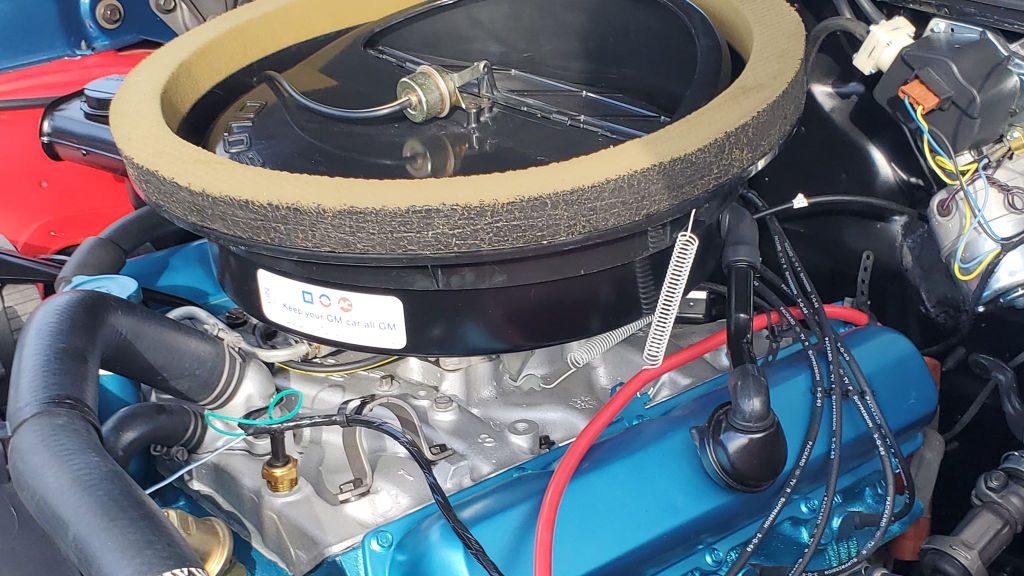
VIN: An acronym for “vehicle identification number,” a unique code assigned to each individual vehicle for identification purposes.
W-30: A high-performance big block 400 and 455 cubic inch V8 engine option produced by Oldsmobile used in the 4-4-2 from 1966 to 1972. It included a high-performance engine, upgraded suspension and brakes, and unique exterior features. The package also included a Forced Air Induction system, a heavy-duty radiator, a high-performance exhaust system, and special badging.
W-31: A high-performance small block 350 cubic inch V8 engine option produced by Oldsmobile used in the Cutlass and F-85 models from 1968-1970. It included a high-performance engine, special camshaft, cylinder heads, exhaust manifolds, a high-capacity oil pump, and a heavy-duty radiator. It also featured a Forced Air Induction system, a larger sway bar, front and rear, and special wheels.
Wedge: This term refers to the shape of an engine’s combustion chamber, which is wider at the top than at the bottom. It was used by American car manufacturers such as Chrysler, Dodge, and Plymouth.
Winged Warrior: This term refers to a car with large aerodynamic wings on the rear, intended to improve downforce and stability at high speeds.
Wide Ratio: A manual transmission type featuring wider gear ratios, commonly used on high-performance muscle cars for improved acceleration and top speed.
Window sticker: A label affixed to the window of a new car containing information about the car’s options, features, and pricing.
Windsor: Ford’s 351 cubic inch V8 engine is known for its durable construction and high-performance capabilities.
W-Machine: This was a high-performance version of the Oldsmobile 442, which featured a 455 cubic inch V8 engine and other performance upgrades.
X-pipe: A type of exhaust system featuring a crossover pipe that connects the two sides of the exhaust system, commonly used on high-performance muscle cars for improved exhaust flow and performance.
XR-7: A luxury Cougar model produced by the Mercury division of the Ford Motor Company from 1967-1979. Depending on the model year, it added leather seats, wood grain trim, rally gauges, special badging, and more.
Y-Z
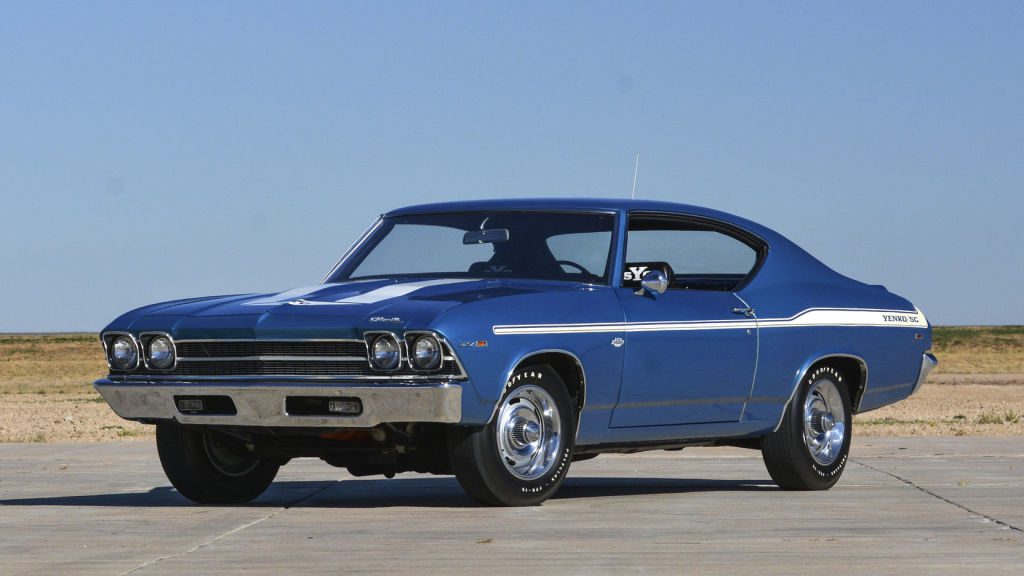
Yenko: A performance shop owned by Don Yenko, known for producing high-performance versions of Chevrolet muscle cars in the late 1960s and early 1970s.
Yenko Deuce: This was a high-performance version of the Chevrolet Nova, modified by legendary tuner Don Yenko. The Yenko Deuce featured a modified engine and other performance upgrades.
Z/28: A high-performance version of the Camaro made by the Chevrolet division of General Motors from 1967-1974, 1977-1988, and 1991-2002. The option code “Z28” was created for a specific race-ready engine package that Chevrolet wanted to use in the SCCA Trans-Am racing series.
Z16: A high-performance version of the Chevrolet Chevelle produced in 1965, featuring a powerful 396-cubic-inch V8 engine and other performance upgrades.
ZL1: A high-performance COPO engine option produced by Chevrolet in the late 1960s, featuring an all-aluminum 427 cubic inch V8 block and head design for improved performance and reduced weight.
Conclusion
The muscle car era may be over, but its legacy lives on in the hearts of enthusiasts worldwide.
By exploring this glossary, you’ll better appreciate the engineering, design, and performance that made these cars special.
From the rumble of a big-block V8 to the sleek lines of a fastback body, the muscle car will always symbolize power, rebelliousness, and American ingenuity.

Ryan Wheaton
Ryan has owned muscle cars since 1986 and currently owns a 1972 Dodge Charger Rallye. He combines passion and experience to create engaging content for fellow muscle car enthusiasts. In 2018, he founded Muscle Cars Illustrated, authoring hundreds of articles on tips, history, and trends in the muscle car industry. He attends national car shows, auctions, and museums to stay current with the latest developments in the muscle car industry.
